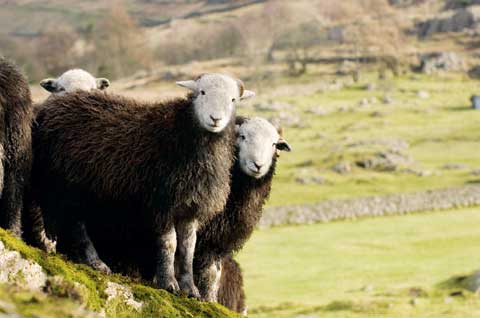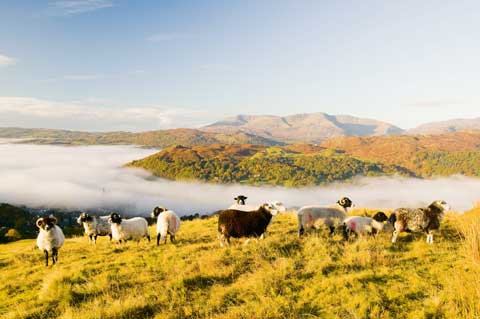Natural England’s fresh approach to hill farming

The day-to-day management of upland livestock is a constant challenge to those farming in the hills. So it has been no surprise to see resistance to some of the environmental prescriptions underpinning the new agenda of “green” support for hill farming – as well as criticism of rules that enforce stocking rate reductions.
But the more conciliatory approach now being adopted by Natural England – driven by farmer pressure for more dialogue and the need for a greater understanding of upland livestock management issues – looks set to establish a working framework to enable hill farmers to feel their businesses are being supported, rather than threatened, by the need to preserve the upland environment.
It is fair to say there has been a disconnect between Natural England and hill farmers, says Adrian Vass of Natural England.
“We haven’t always appreciated their point of view. Now we’re putting that right and, among other things, are developing a closer working relationship with the farmer members of grazing groups now established in Cumbria, Teesdale, Dartmoor and the Peak District.”
But how will this new era of understanding by the environmentalists be applied to the way hill farmers actually manage their sheep flocks and suckler herds? The resolve of the environmentalists to preserve the upland habitat hasn’t weakened, so has this change of heart just come in the nick of time to bolster confidence in the hill farming sector?
Many hill farmers in an ESA (Environmentally Sensitive Area) scheme or a Countryside Stewardship scheme are seeing their agreements coming to an end. Now they are asking how new environmental demands will be achieved and how they will impact on the way their farms are managed and stocked in the future
NEW GENERATION OF ENVIRONMENT SCHEMES
Shifting from the “old” schemes to the new generation of environmental stewardship packages seems daunting and off-putting for many. And the fact there is no automatic switch to the new Upper Entry Level Scheme or the Higher Level Scheme isn’t helping.
Balancing all of this with the need to maintain viable hill farming businesses is a big issue. Payments under the ESA have been a lucrative income booster for some hill farms, but moving to a UELS Upland Entry Level Scheme will mean a reduction in what has been earned. Moving to a Higher Level Scheme will mean an increase in “green” income – but in this case it has to be justified by meeting the requirements of the scheme, rather than being paid for leaving the landscape to its own devices.
LOST INCOME VS STRICTER RULES
This is the area giving cause for most concern. Hill farmers see income being lost unless they agree to the more demanding set of green rules that they perceive will be more difficult to deliver without disrupting the management strategy that’s in place on their farm – a strategy they know they have to follow if their businesses are to remain profitable.
“It’s in our interest to ensure hill farms remain viable and we want to do all we can to help farmers meet the needs of agri-environment schemes without undermining any of the practicalities of hill farm management,” says Mr Vass.
Even though some of the prescriptions may seem inhibitive – and some farmers may feel they hit at the very core of traditional upland beef and sheep management – Natural England believes there are innovative ways these issues can be resolved.
Stocking rates under HLS is one of the most contentious topics among upland agri-environment schemes where heather moorland re-generation is considered necessary. But Natural England recognises that the number of sheep that can be sustained on a hill farm is critical to its profitability.
“We recognise that stocking rates must be based on two considerations – science and local experience. But we’ve got to start finding practical ways of enabling farmers to maintain the viability of their flocks and still fulfil agri-environment requirements,” adds Mr Vass.
NATURAL ENGLAND AND FARMERS WORKING TOGETHER
An example of the compromises being reached can be seen on a farm in Northumberland, where there were 550ha of grazing. Stocking rates were too high. Although the farmer was given three years to reduce his ewe numbers in order to meet the HLS requirement, he felt it would have been detrimental to the viability of the farm.
Natural England suggested a compromise. Recognition was given to the importance of maintaining the farm’s hefts – which were under risk if sheep had been removed during the winter.
“We recognised the farmer’s concerns and agreed that the hefts had to be maintained, so we looked at the number of five-year-old draft ewes on the farm. Based on that, we kept the young sheep and the middle-aged sheep on the heft, but took off the five-year olds that would be leaving the farm the following year.
“We struck a deal with a local landowner who had land to rent for winter keep and we moved, after tupping, all the five-year-old sheep until the spring, when they will be sold with lambs at foot.
“We want to be innovative, we want to find solutions and we want hill farmers to stay in business,” says Mr Vass.

CASE STUDY
Carl Walters, Bampton, Shap
Cumbria hill farmer Carl Walters took over the tenancy of Low Hullock Howe Farm, Bampton, near Shap, nearly 26 years ago, and while there have been considerable changes to the sheep stocking rate over that time – and cattle numbers are also currently being reduced – he continues to prove that farming in conjunction with a range of environmental prescriptions is workable.
“It’s all about maximising what you can get out of it without comprising the business in the process,” says Mr Walters.
The farm extends to 110ha, running from 500ft to 1,200ft along with fell rights on Bampton Common. There are 850 Swaledale ewes – 500 on the common land – but suckler cow numbers are being reduced from 65 to about 40 to comply with the SCAMP (Sustainable Catchment Management Programme) project being undertaken by United Utilities, who own the farm. It will mean all cattle can be in-wintered in covered buildings.
Mr Walters, who farms with his wife Ruth, has taken on more land locally as it has become available over the years, including 28ha that have been purchased.
Although sheep numbers have been almost halved to meet stocking reductions on the common, the extra land now means all sheep can be wintered at home rather than sent away on tack.
“We’re now just starting to work within the HLS, but over the years we’ve always tried to strike a balance between the commercial needs of the farm to earn us a living and allowing the land – and the way we farm it – to benefit the environment,” he says.
Despite being a hill farm there’s an ongoing project – instigated by United Utilities and the RSPB – which grows a 12ha rotation of barley under-sown with grass at almost 1,000ft.
The crop, which provides valuable stubble for wintering birds and for nesting lapwings in spring, is round-baled as a whole-crop feed for sheep and fulfils part of the HLS requirement.
“The benefit to us is that we have an excellent feed for the sheep and we are regularly re-seeding 12ha of ground. Originally, the idea was to grow the crop in small areas, but by putting it onto a field-scale it’s brought more significant benefits to the farm, as well as to the environment.
“Within the ESA scheme we had to agree to take this land out of production and received no payment. Now, in HLS, we receive a payment of £250/ha compared with £12/ha we received through the ESA.”
The farm, which is also in UELS, was undertaking enough environmental prescriptions within its ESA agreement to quality for HLS.
Hay meadow restoration is also under way and another 5ha suited to meadow preservation will be put into the scheme. Hay meadow creation earns £280/ha and restoration is worth £200/ha.
“The HLS is more constructive in the way it encourages you to introduce environmental practices that can benefit the farm compared with the ESA scheme, which was more restrictive.
“That approach should be the essence of all environmental schemes applied to hill farms – to grow what you can on your most productive land and designate less productive land for an environmental agenda.”
Mrs Walters says: “The HLS for hill farmers is much better than the ESA because you can pick and choose what you do. We chose not to gain points from the mixed grazing option – even though we practice it – simply because of the extra monitoring, paperwork and record keeping involved.
Fencing off water courses has also been undertaken as a “point winner” under HLS.
The Walters, who work closely with their local Natural England adviser, believe the attitude to farmers and their roles in environmental management is changing.
“There’s been a very recent change in the way farmers’ concerns are being recognised. It’s taken a long time, but at least it’s finally happening. We’re seeing a much more positive response to our concerns and a clear awareness that farmers are the ones delivering the environmental prescriptions. But to do that we have to be here, and to be here we have to have viable businesses,” Mr Walters.
